2015 Mid-Size Truck Shootout: Colorado vs. Tacoma vs. Frontier + Video
2015 Mid-Size Truck Shootout
Pulling Power
Although not known for being serious haulers, chances are good that quite a few mid-size truck buyers will use their vehicles to tow something at some point – even if that’s nothing more than a small U-Haul trailer. Although the Nissan certainly focuses on offering value by providing extra features, we were surprised to see our PRO-4X did not feature a tow hitch in spite of its 6300-pound rated tow-capacity. Nissan does have a location for a bumper-mounted tow-ball, although this would only allow for the towing of smaller trailers. Without its optional tow package, we had to exclude the Frontier from this portion of our testing.
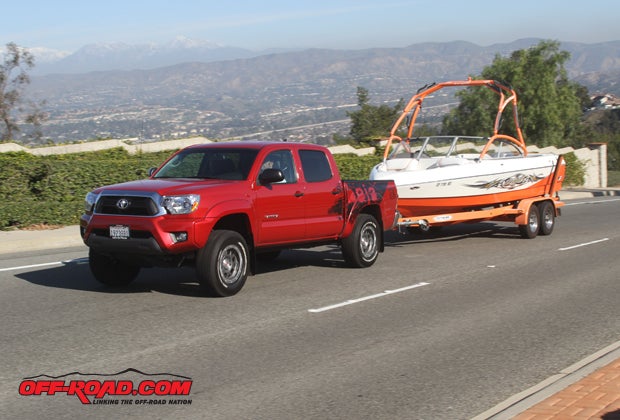
We did tow with the other two trucks in our group. The Tacoma Double Cab model features a 6,500-pound tow rating, and the Chevrolet Crew Cab features a tow rating of 7,000 pounds. Our trailer test involved hooking the trucks up to our pal Chris Thompson’s 22-foot Tige wakeboard boat and trailer, which scaled-in at just over 6,000 pounds. We then towed it through a test loop that includes some twisty curves and a hill that starts out with a 6 percent grade before increasing to a demanding 12 percent climb.
We hooked the boat up to the Colorado first and were impressed with its torque delivery and acceleration from stoplights. At the start of our hill climb, we thought the new Chevy pulled fairly well up the 6 percent grade; however, it did show its “mid-sized” truck limitations as our test driver, Thompson, said that the back end felt “a little light” guiding the heavy trailer around turns, although the Chevy had little trouble powering up the 6 percent grade.
As the tow continued into the demanding 12 percent grade, a slope much more demanding than most owners will encounter, the Colorado did begin to struggle a bit compared to the preceding 6 and 10 percent sections. The Chevy made the hill without having to bang off its rev limiter for the length of the climb, and Thompson noted, “It did better than I thought it would but it did have to work hard on the steepest section.” Heading downhill, the Chevy felt relatively confident and tracked straight. This could be attributed to its sturdy chassis feel and its confidence-inspiring brakes. Sure, the weight of the big Tige could be felt, but that could be expected, considering we really pushed right up against the tow capacities for these trucks. Proving it can pull a 6000+ lb. boat and trailer combo up a 12 percent grade, tells us it would be an absolute breeze to pull a more moderate load just about anywhere with the new Colorado.
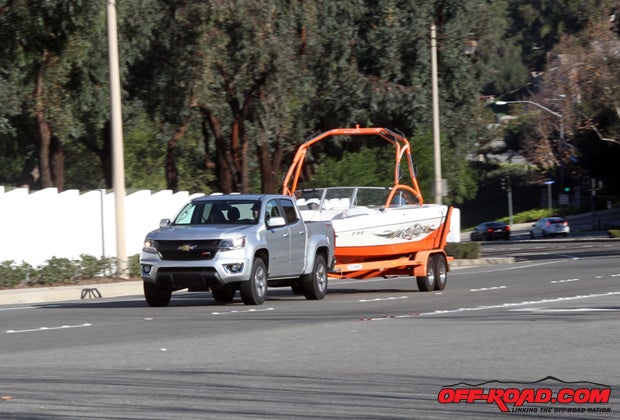
The Tacoma TX Baja was next to lug the wakeboard boat and trailer up and down our curvy, hilly test loop. As we started up the initial 6 percent grade, Thompson quickly noted that the Toyota was struggling with the load. Not only did it feel less powerful than the Chevy, but we also noticed the weight of the trailer moving-around and steering the Tacoma’s back-end much more than we did in the Chevy. The weight of the boat-trailer combo felt like they pulled the rear end of the Tacoma around more in the turns. which may be partially due to its taller stance on the TX package suspension. Once it found its stride higher up the tach, the Tacoma got the job done on the 6 percent grade. Once we transitioned onto the 12 percent grade, the Tacoma hovered around a full-throttle top speed of 30 mph. It did make it up the whole grade, but it was clearly a struggle. On the downhill side, the Tacoma’s relative virtually non-existent engine braking compared to the Colorado also meant that Thompson leaned-on the Tacoma’s brakes more, saying, “It wants to keep running.” The manual shift doesn’t offer much assistance in towing applications, either, as the transmission’s ECU ends up overriding the manual entry anyway. The Tacoma’s braking power is lacking compared to the other two trucks, and that’s no surprise as it is the truck in the group still equipped with drum brakes on the rear axle – a fact that was not lost on us while towing down-hill.
Our tow testing deliberately approached the limits of the trucks. Each truck would certainly be much more comfortable pulling a normal camper trailer, or one filled with dirt bikes, ATVs, etc. Towing a heavy boat through the mountains is certainly possible, though we wouldn’t recommend a mid-size truck for that job if it’s something you intend to do on a regular basis.
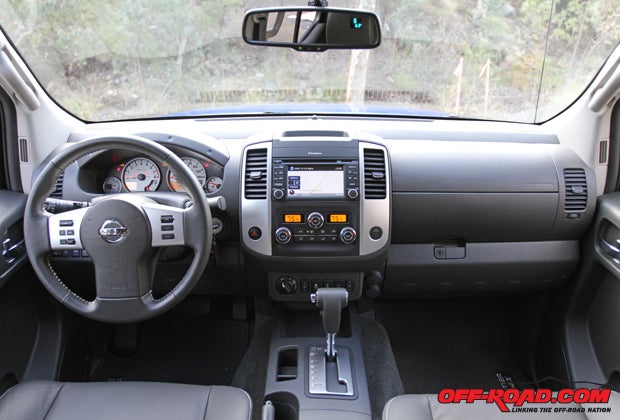
Ergonomics and Features
With the Frontier and Tacoma last receiving any major updates around a decade ago, there are plenty of things that fall a little short on each truck. The Frontier’s interior is relatively quiet, bright and roomy, but its dash layout and interior styling feels out of date. The Frontier’s leather seats have a hard, slippery and flat feel, and these front “buckets” don’t offer much support for the driver and passenger. Rousseau noted “If it wasn’t for seatbelts, I got the impression that my ass would have been skating all over the place around every corner.”
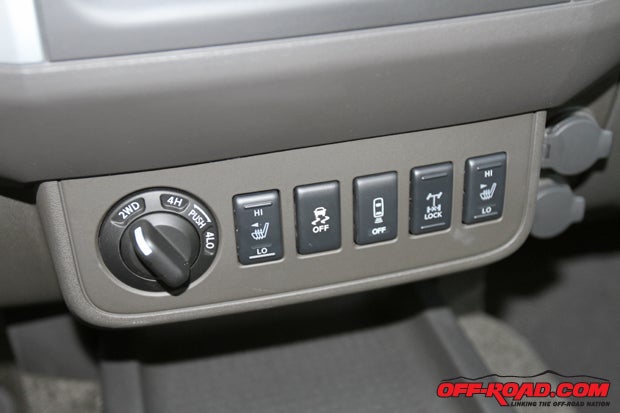
The interior and dash, while functional, are clearly dated, but as Alexander noted the old-fashioned low window sill line is much more comfortable for resting an elbow on with the window down – offering the old-school feel many of us associate with the word “truck.” Alexander also noted the tall seat-to-floorboard distance put the driver in a comfortably upright position, especially compared to the lower-to-the-floor seats in a Tacoma. The power seat adjusters are another nice feature on the Frontier. The steering wheel control switches for the Rockford Fosgate stereo and Bluetooth phone functions work fine but could desperately use a styling update.
The Colorado offered the quietest cabin of this group by far due to its more modern aerodynamics coupled with superior chassis and powertrain refinement. When we first drove the Colorado at its press introduction in Del Mar, California, Chevrolet explained their emphasis on reducing cabin noise was due to it being a major sticking point heard during research with current mid-size truck owners. So the triple-sealed doors with inlaid seams, fibrous liners in the wheel arches, liquid-applied sound deadener, and under-floor acoustic absorber certainly aid in its quiet ride. Inside, the Colorado’s cab isn’t cramped but its low roof height and shorter glass might not endear it to full-size truck fans looking for airy panoramic sight lines.
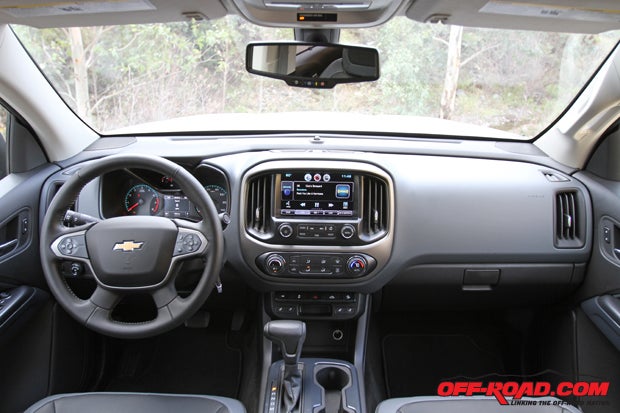
Fortunately, the Colorado has a power height-adjustable driver’s seat – so finding that sweet spot is simple. It also has large, easy-to-see mirrors that really help the driver’s situational awareness. The Chevrolet is designed to fit two adults up front with three across its rear bench, but like every truck in the class we wouldn’t want to be the unlucky individual in the middle of the back seat.
Since the Colorado is the newest truck of the bunch, pretty much everyone noted some level of disappointment with the hard “plastic” trim pieces used in parts of the interior. While the materials were not a bother in terms of appearance, they fell-short when actually touched or heard. The center stack is really well laid out, with everything fitting seamlessly from the piano-key functions at the bottom of the stack, to the 8-inch touchscreen that features easy-to-use controls for HVAC, stereo and navigation. The steering wheel mounted controls worked well, and the only real complaint regarding with the Colorado centered around its 4WD dial being on the left of the steering wheel and the fact that the system’s orange indicator light was very dim and difficult to see whether you were in 2WD, 4 Hi or 4 Lo.
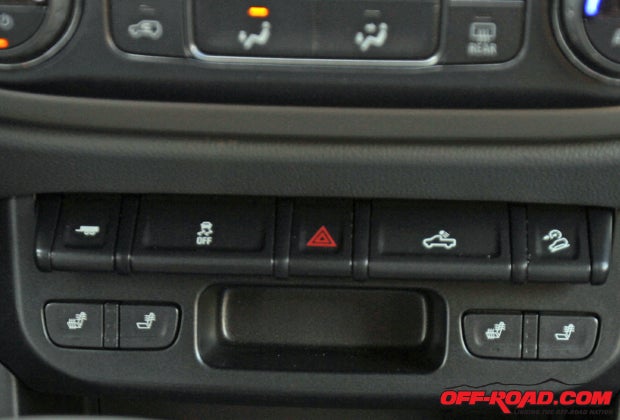
The ergonomics and overall comfort of the Colorado, both front and rear, were universally praised by our testers. The seats themselves offer a nice wraparound feel that helps keep driver and passengers in place during hard cornering, and its seats are friendly on the backside. Some of our testers complained that the soft foam may compress and end up becoming uncomfortable on very long rides. The Colorado also takes seat heating to the next level, outdoing the Nissan by not only offering three levels of heating for the driver and the front passenger but also the ability to choose between seat heating, backrest heating, or both. As Rousseau said, “Don’t think that will be lost on customers who live in cold climates.”
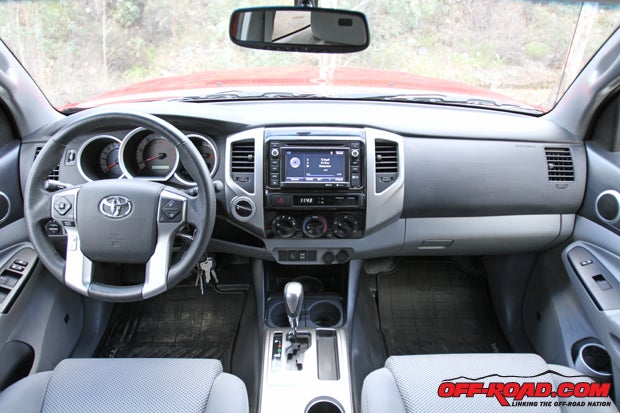
The Tacoma is the noisiest truck in this class, and its interior, while spacious, is in need of a serious upgrade. Aesthetically speaking, it looks a little out of date compared to the Colorado and even the Frontier. Rousseau said, “The Tacoma’s dash layout just looks old-school to me, from the rotary dials of its AC and heating controls to the location of its digital clock.” Alexander was emphatic about it being “the most dated interior of the bunch.” Its seats are comfortable enough, but the Tacoma’s floorpan is shallow and its seats are low enough that it seems to force front seat occupant’s legs out in front, rather than underneath them, when seated. Our taller testers have the most to grumble about in this department, with Alexander at 6’2”and Burns at 6’0”, but even the shorter Rousseau expressed his displeasure with the Tacoma’s “go-kart” seating position.
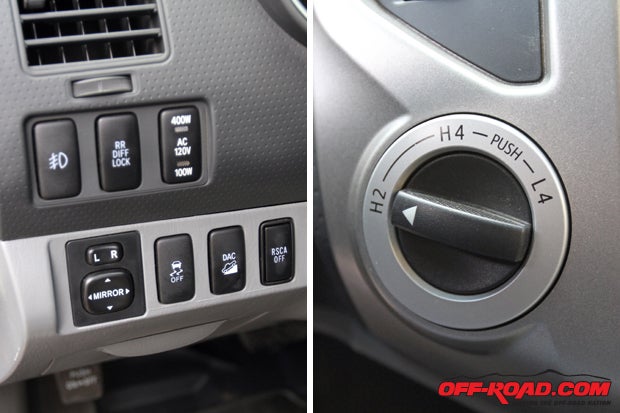
The easy-to-find 4WD mode select dial is both easier to see and to reach than the Chevy’s, and there is no doubting which mode you have selected. The Tacoma’s steering wheel mounted controls for stereo and phone are well laid-out and easy to use.


 Your Privacy Choices
Your Privacy Choices